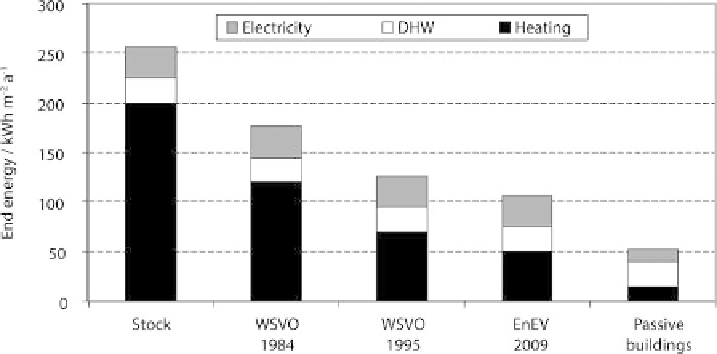Environmental Engineering Reference
In-Depth Information
Figure 18.2.1
Energy demand for the existing building stock and subsequent legal requirements in
residential buildings per square metre of heated floor space Germany.
heating requirement of buildings. Only with very energy-conscious use of an unheated
conservatory can energy gains for the building actually be achieved.
How efficiently solar gains can be used by a building depends on the ratio of gains
to heat losses. The higher the heat losses, the better solar gains can be used. In well-
insulated buildings with low losses, however, solar heat gains often cannot be used, as
they might overheat the buildings, especially when the thermal building mass is low.
Most countries now regulate heat losses. In China, which has severely cold regions
(between 5500 and 8000 heating degree days), exterior walls for three-storey build-
ings are supposed to have heat transfer coefficients (U-values) below 0.33 W m
−
2
K
−
1
,
and for high rise buildings below 0.48 W m
−
2
K
−
1
, whereas in temperate regions
0.5Wm
−
2
K
−
1
are sufficient. In Japan, today's wall U values are between 0.39 and
1.76 W m
−
2
K
−
1
depending on climatic condition, and in Korea between 0.47 and
0.76 W m
−
2
K
−
1
. Figure 18.2.1 shows the development of energy requirements in
Germany.
In Europe, with its wide geographical extent of nearly 35
◦
geographical latitude
difference (36
◦
in Greece, 70
◦
in northern Scandinavia), a wide range of climatic
boundary conditions is covered. In Helsinki (60.3
◦
northern latitude), average exte-
6
◦
rior air temperatures reach
−
C in January, while southern cities such as Athens
at 40
◦
10
◦
C. Consequently, building standards vary
widely: whereas average heat transfer coefficients (U-values) for detached houses are
1Wm
−
2
K
−
1
in Italy, they are only 0.4 W m
−
2
K
−
1
in Finland. The heating energy
demand determined is comparable in both cases at about 50 kWh m
−
2
a
−
1
. The nec-
essary U value to achieve the passive house standard with less than 15 kWh m
−
2
a
−
1
heating energy demand for several climate zones is shown in Table 18.2.1. In addition
to heating energy requirements, residential buildings require energy for domestic hot
water, electricity consumption and cooling in hot climates.
latitude still have averages of
+

Search WWH ::

Custom Search